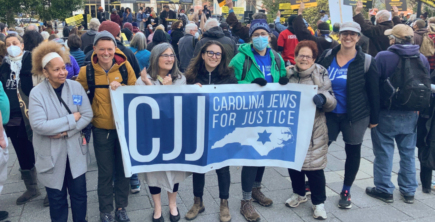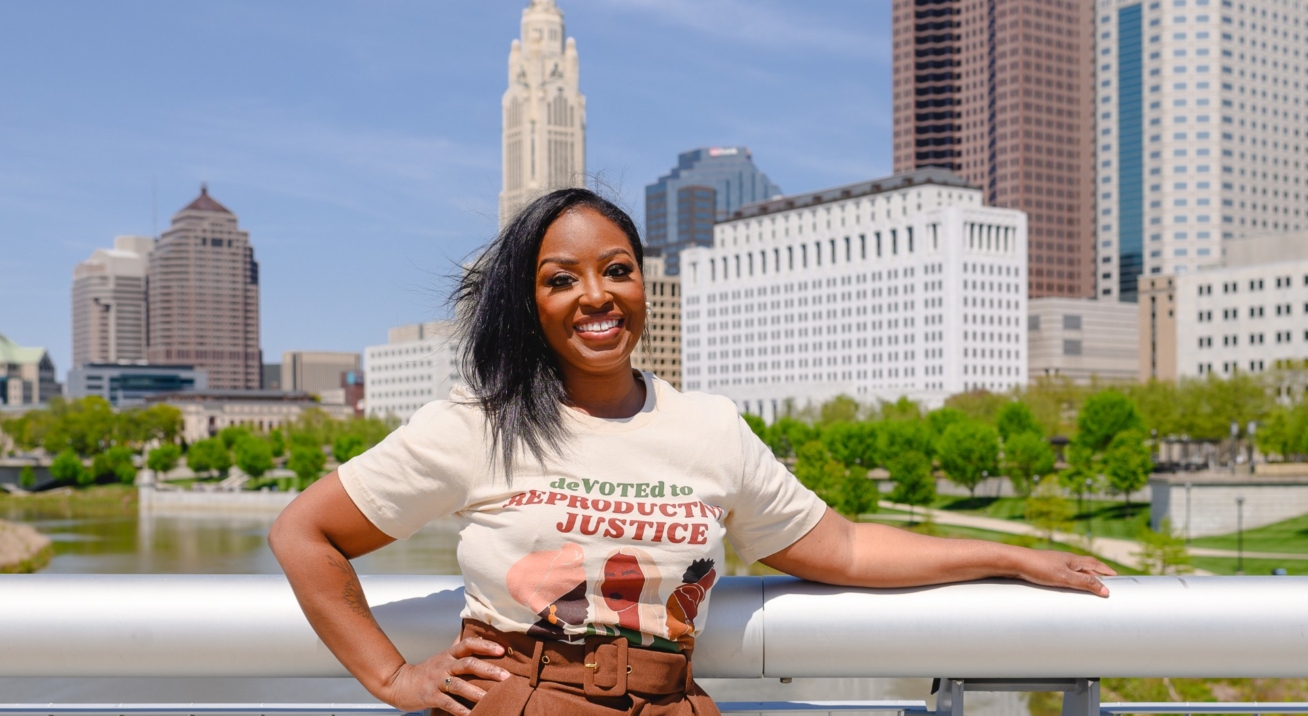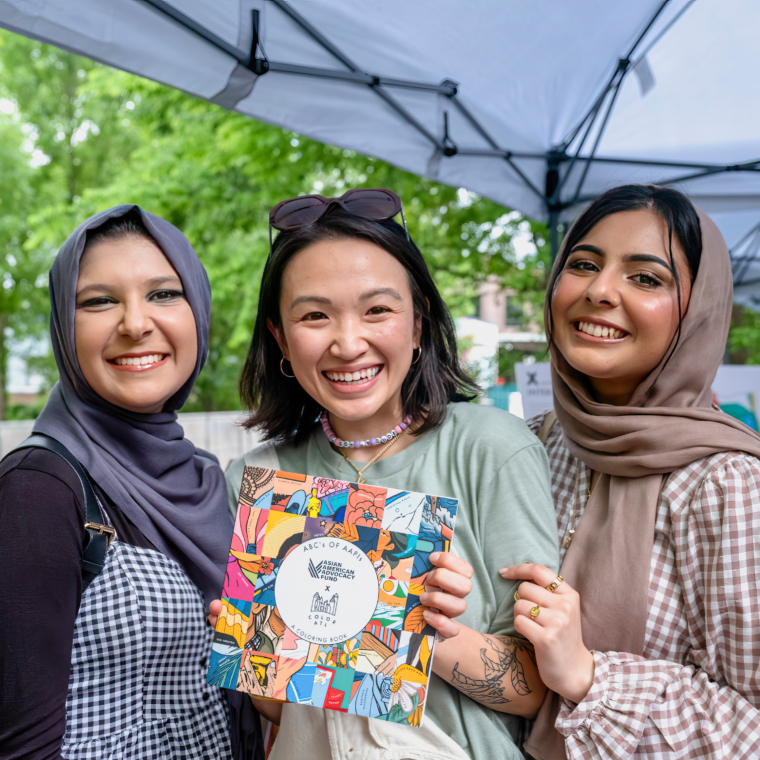
Our Community

Last year, Rhiannon Carnes — a Tides Jane Bagley Lehman Award winner — led the Ohio Women’s Alliance in reaching out to 1.3 million voters to secure abortion access in Ohio for generations to come.
With abortion on the ballot in 10 states, she spoke with Tareya Palmer, Program Officer for Tides Foundation’s Just Health Fund, to talk about how Ohio’s abortion ballot measure succeeded by embracing a reproductive justice framework and the importance of building a movement sustained by joy.
Watch their conversation now, or read highlights from the discussion below.
RHIANNON: Community organizing is where I started out at, at the local level. I started my work in 2016. I was definitely outraged at that time by the attacks on women’s reproductive rights, as well as the attacks on people who are racially oppressed. Prior to that, I was in the military, in the Air Force. I also spent years in the health care industry as a respiratory therapist and health care administrator. And so I had a lot of experiences in situations where there wasn’t representation for women, especially women of color and Black women.
I’m also a mom. I have three children, biologically, that are mine. I’ve been an adoptive parent before. I also have bonus children — I’m newly married (couple of years). But I have bonus kids. And so my reproductive journey is very expansive and diverse. So this was an issue that was important to me.
RHIANNON: When I first started Ohio Women’s Alliance, just from my own experiences, I realized there wasn’t a space that really invested in women of color — Black women who really wanted to be intentional about the work that needed to be done in our community. There weren’t spaces that really invested in our leadership. There was no blueprint to show us the way, especially when it comes to building an organization.
And so the founding premise of OWA is really rooted in making sure that we are equipping leaders in our community — people who really want to step up and make a difference — and that they have the resources to be able to thrive in the work that they are doing.
There are so many incredible Black women in our in our state who are just doing the good work, and we may not know of each other or know of the hardships. I think so often we’re uplifted when the work is great, and there’s an uplifting of the exceptionalism of Black women. But there’s struggle in that work, too.
We need to be more transparent, but also make sure that we are learning from our experiences and that people don’t have to go through the same trauma and struggle that we went through. I want to make it easier for people to step into their leadership.
TAREYA: I think that’s really important to underscore, because I think that while people say “listen to Black women” and “let Black woman lead,” that is very hard for folks to actually put into practice and do.
I think that when we are equipped with the right supports and all of the things that we need to lead, we do an amazing job. But I don’t appreciate the term “Black girl magic.” We are just like everybody else. We experience struggles just like everyone else, and we need the support to be able to do the work that we’re so passionate about across the spectrum. It’s not just in reproductive justice. There are so many Black women and women of color who are quietly doing stuff that nobody else wants to do. And they get up every day, and they don’t necessarily get recognition for that.
RHIANNON: [Dobbs] was a devastating moment, but I think it created space for us to come together and build collective power. That decision and the attacks in our state on reproductive rights, health, and justice were meant to dismantle our organizations and tear us apart. But, since then, in that short period of time, we’ve grown from a staff of three to a staff of nine. So not only did it do the opposite of what they thought it was going to do, it actually created opportunity for us to thrive.
One of our first reactions was to make sure that we were taking care of ourselves…. We launched our member assistance program, which is a practical care support fund for abortion seekers in our state where they can receive transportation, lodging, childcare and food stipends and lost wages. Making sure that people not only have the right to abortion, but that they have access to obtain that right. There are so many barriers that women of color and people in poverty face.
Not only do we service abortion seekers in our state, we service those who come to Ohio because there are states that have gone dark that don’t have access. Thirty-one percent of our clients come from out of state. So, for us, it’s about how can we continue to make sure that we are caring for those who are in need?
RHIANNON: For so long, Black women and women of color were saying the right is just simply not enough, Roe was was not enough, and that access needed to be strengthened and expanded. And in Ohio, when we did launch our ballot measure, the language in our ballot measure embodied the reproductive justice framework. It wasn’t just abortion that we were protecting in the ballot measure, but it was also the right to continue pregnancy. It was also the right to contraception, the right to fertility treatment, and the right to miscarriage care…. That is truly how we won the ballot measure, because we went a step beyond just the right to abortion.
I think that’s so important, because that work was initiated and started and founded on the shoulders of Black women. Even myself, as a Black woman, when we launched the ballot measure I actually was out on maternity leave…. When the Dobbs decision dropped, I was pregnant. I was 44 and pregnant, so I was high risk, and being able to have access to abortion would definitely have been lifesaving care for me at that time if I had needed that form of care. And so, I think for me, this is my personal life. This is the life of my children as well.
And so I feel, as I’m sitting here trying to follow the legacies of those Black women who’ve been doing that work, that I also have an obligation to move that work forward.
RHIANNON: I think what this ballot measure has demonstrated is that when we prioritize and center the issues of the people, people will show up on the right side and show up for progressive issues…. We have been feeling like we’ve been losing power, but what we always knew was that we had the people power.
And they threw everything at us, with the August special election to try to increase the threshold to 60%. Ohio has 88 counties, and to get on the ballot you have to have signatures in at least 44 of those counties, as it stands. But that August special was trying to increase the signature requirement to all 88 counties.
We were prepared. When we launched our ballot measure, we were doing the work out in the field with the intentions that anything that they threw at us, we were still going to be able to overcome it and fight.
With the special August election, the Ohioans shot it down. They said, “Absolutely not. You can go somewhere with that.” And so that was our first fight. And again, the turnout in that fight was unprecedented. They put that on the ballot in August, in the summertime when they thought people would be distracted or focusing on their children and vacationing. But Ohioans were not distracted. They showed up.
RHIANNON: I will say that launching a ballot measure takes a lot of collaborative and collective work. Our folks in Ohio who prioritize reproductive rights, health and justice have been doing this work for a long time. We’ve been building partnerships for a long time.
This type of work and this type of campaign is very expensive. It was national news. That work doesn’t happen by itself. And so you must be doing the pre-work within your state before you launch a ballot measure. You must be collaborating and working with each other, understanding your own organizational strengths, what you bring to the table, your assets.
We can’t just come together during a crisis. We have to work together, because each of our bodies of work reflect each other and support each other.
RHIANNON: For so many Black women, there’s so much weight put on our shoulders, especially when we enter spaces and we are the only one. Too often we are the only one. For [the ballot measure campaign], Ohio Women’s Alliance was the only Black-led organization at the founding table. And so that is an enormous responsibility to hold. There were so many eyes on Ohio, and we knew that our work here would be viewed as a catalyst for other states. And other states are literally modeling what we did and how we approached the work here. I get a lot of requests from out of state partners to share my knowledge and the way that we approach the work here.
It was a heavy weight. As I mentioned, I had just given birth at the time, and when it comes to maternal mortality rates, Ohio’s just like many other states across the country where Black women are two and a half more times likely to die than than white women when giving birth or during that postpartum year. And that is where I was at. I was in one of the most vulnerable phases of my life.
So for me, I definitely had to prioritize my mental health a lot. When you’re the only one, you’re always being tapped for all of the — just so they can represent us and say that we do have Black women and people of color in this work. I can’t answer every single request. I’m only one person. I don’t represent all Black folks. So it was a lot of boundary setting for me. Not feeling guilty when I needed to say no when I was at capacity. And prioritizing my own ability to be able to show up. But then also there was some internalizing for me and guilt as well. I think we too often feel that as Black women, because we feel like we have to save the world. But life will go on, the world will still turn. And there are other people who can do that, and folks need to go find them. And it’s additional labor for me, too, if you’re asking me to go find them. So sometimes the answer is no and no.
TAREYA: And no is a complete sentence.
RHIANNON: Right, that’s right. I’m thankful for the other women of color on my team and who surrounded me and uplifted me. You know, when I was tired, they were able to step in. Jordyn [Jordyn Close, Deputy Director of OWA] was incredible in the way that she showed up for the ballot measure. She ran our field programming, but she was also instrumental in prioritizing and uplifting and centering abortion storytellers.
Jordyn is so gracious in the way that she shares her personal story. And I think that had a major impact in resonating with people, making sure that we’re not just exploiting the experiences of people and sharing stories that provoke trigger warnings and things like that, but actually normalizing the experiences and the decisions around abortion access.
TAREYA: Absolutely. I’ve heard Jordyn share her story, and I’ve been really appreciative when Jordyn does that and when I hear the stories of other folks. I appreciate that framing as well. Not everyone is sad and upset when they have made the decision to have to have an abortion.
And I think that framing is really important. There’s always this narrative around pain, particularly when it comes to Black birthing people or Black people in general.
RHIANNON: For me, when it came to the ballot measure, the outcome was always going to be joy, whether we won or lost. For us, it was about determining what that joyous moment was going to be. We determined our wins. I knew sitting at this table was a win in itself. To have representation, for people to know that there are Black women who advocate for abortion access, regardless of the shame and stigma placed on us and our lives. And not just around abortion, but even around pregnancy — there’s a lot of shame and stigma around Black women choosing to give birth.
I’m thinking about the ability to have those joyous moments. A lot of fights historically have rested on the lives, pain, and struggle of our work. A lot of the work celebrated today did not start out as a celebration. When we think about LGBTQ+ rights and Pride, those fights started as struggles and rested on the shoulders of Black folks. For me, it’s a celebration — celebrating the joy, the pain, and the fight. But yeah, we have to find joy. If we don’t, how will we take care of ourselves? How can we continue to be mentally whole and well?
RHIANNON: We cannot legislate our way to freedom and liberation. We know that the legislative system in the state was not designed to free all of us, especially Black folks. There’s so much historical harm when it comes to the legislative body and laws that have been designed to disproportionately oppress and criminalize us.
We did not find ourselves oppressed single-handedly. We did not place ourselves at the margins. It was more than just the laws; it’s also the systems, institutions, and structures. There’s also the oppressive culture that has kept us at the margins. So it’s going to take more than one way to uplift our communities. It’s going to take more than just policy.
Yes, policy is one of those ways, but direct services is also another. It’s our collective voting power and purchasing power. It’s educating others about the work in whatever field we’re in. It’s also about long-term destigmatizing and cultural narrative change work. We cannot simply think that there’s just one path to freedom because there isn’t. We need folks to show up for each other in whichever way is best for them. We’re not asking folks to do all things; you don’t have to be a superhero. Just do something.
This conversation has been edited for length and clarity.

Read the stories and hear the voices of social change leaders fighting for justice.